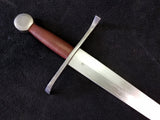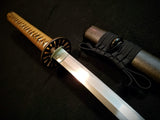Kingston Great Sword
The sword commonly called a Great Sword, is a design that is commonly associated with German and Swiss Landsknechtes of the 15th through 17th centuries. However, with the advent of pike and shotte warfare sweeping across Europe, many nations developed swords along these lines under their own nomenclature, such as the beihander, zweihander, montante, and spadone.
These swords served two main functions. Firstly they were used by bodyguards, who could sweep these blades in great arcs to deny access to entire areas and prevent ne'er-do-wells from accosting their clients. Secondly, they were used by specialized soldiers for the purpose of cracking open pike formations, sweeping the pike heads aside and allowing troops behind them, or the soldiers themselves, to charge into the gap and tear the pike formation apart.
Additionally, the parrying hooks part way up the blade found on some models allowed the blade to be wielded with, essentially, two different gears. By holding the traditional handle, the blade could be wielded as a heavy and aggressive cutter. By moving the forward hand under the parrying hooks, the blade could be wielded with greater dexterity, more akin to a longsword. This provided a skilled user with an excellent flexibility that, in the case of the Landsknechtes, entitled the soldier, known as a Doppelsöldner (Double-pay man) to twice or more the pay of his peers, though this is disputed.
Specs:
Overall Length: 56 1/4"
Handle Length: 16"
Blade Length: 39 1/2"
Blade Steel: 1566
Blade Thickness: 6.5mm-2mm"
Weight: 5lbs
We Also Recommend








